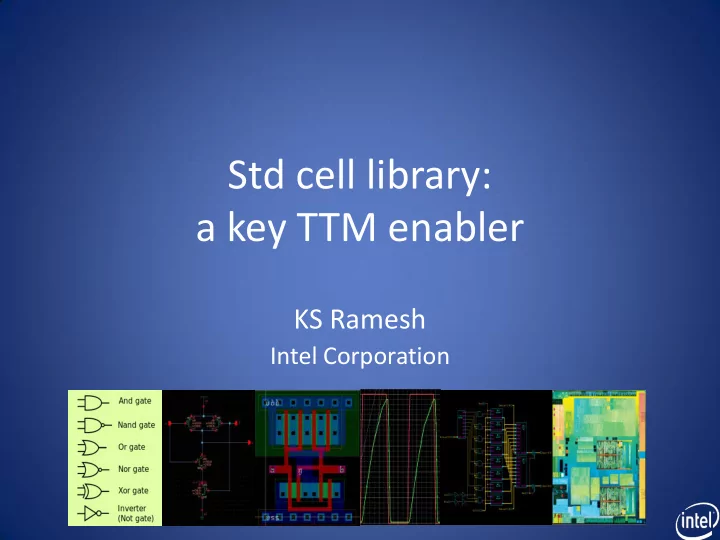

Std cell library: a key TTM enabler KS Ramesh Intel Corporation
Designing with leading edge process tech at Intel • Have unbridled access to the latest process technology • Can tailor your design to process and vice versa, since you control both! • Does this make life easier or harder for design teams ? – Product design runs in parallel with Process development – We do not always have a stable and mature process to start with compared to most others – Product and process targets change mid-course while lifecycle and TTM are shrinking for the industry at large – • How can library help deliver good yielding Si products taking advantage of and maintaining our process lead? 3/15/2014 tau workshop - Ramesh 2
STD CELL LIB requirements • Both high perf CPU and SoC designs include IP’s operating at: – Multiple fixed V power planes – Dynamic range of V (core turbo) – Wide range of temperature – Different corners on the same process node • IP’s need verification across all targeted segments/corners and PVT – Often, these change mid-course during project execution – People at and outside Intel have used MCMM for this • As a customer, ask is always the same: – Ability to (re)generate accurate library collateral in the shortest possible time! – It takes too long! (10K cells, 4 PVT, 4 wks) 3/15/2014 tau workshop - Ramesh 3
Library development • Content: standard cells for digital, analog, cache – jointly developed by Design Technology and FAB Adv Design teams – optimized specifically for Intel manufacturing processes to extract max performance and yield. • Engine: A full-featured internal library characterization tool which generates timing, power and RV model files. – Generates tool views for Synopsys' Design Compiler, Intel STA tool, Primetime, Cadence, Mentor Graphics' ATPG, SALT, Caliber, FEV/Conformal, Verilog simulators, etc. 3/15/2014 tau workshop - Ramesh 4
Why does it take so long? • Extraction, Initialization, cell simulation, model generation, validation and regression. • Init/Sim are accuracy-runtime decisions – WC (dynamic vector initialization) vs static user defined – i/p waveform (pwl @intel vs continuous) – impacts specific topologies like pg/dcn – Container/zone model for wc extraction – #Points in 2D matrix (slope, Cmax) – MIS for max/min – Separate model for setup/hold • Breadth of tool views needed -> validation time • Repeat all of the above for each PVT corner : – V and T flip many init vectors 3/15/2014 tau workshop - Ramesh 5
Statistical modelling We do statistical modelling of variation effects. Advanced On-Chip Variation Modeling For SOC and PT-based HIPs 2-D Tables for delay de-rate factor for setup and hold as function of #of stages and spatial separation Stage-count for std. cell and device level info is included as part of the collaterals Could be MonteCarlo or Nova/MPP based algorithm Users: PT and ICC Le/Vt adjustments to std cell devices based on statistical failure models Used for our custom designs with internal STA tool Can be different for setup/hold Can be edge and device specific 3/15/2014 tau workshop - Ramesh 6
Design and Si • PV Model has not been a good indicator of silicon speed paths. • Majority of speed paths do not come from the PV model convergence tail. • Just pushing the PV convergence target alone is not a sound way to maximize silicon frequency. • There is an uncertainty window around which most silicon speed paths are found. • Goal is to augment PV model with silicon learnings and carry knowledge forward to future projects. 3/15/2014 tau workshop - Ramesh 7
Sources of PV-Si miscorrelation? • Transistor size (z) related Si miscorrelation • Transistor layout topology induced differences in finfet performance • Dynamic V droop • Sensitive Cell topologies (gate i/p vs diff i/p) • Cell loading (lumped vs distributed(pi)) • RC dominated vs device dominated load • Changes in pn skew pre to post Si • Aging • Cmax – variation limits Vmin 3/15/2014 tau workshop - Ramesh 8
Work around or make it faster? • Workarounds used (runtime-accuracy tradeoff?) – Simulation step size – Apply generic vs cell specific Guardbands – Use RC scalars to cover for device ‘V’ scaling – Use MIS where needed – high vs low freq/perf – Bypass power modelling? – Flat scaling the timing models But: • Can we come up with a RSM that takes V and T as parameters to cut setup/simulation time? • Would really like a smart algorithm for input vector initialization across PVT. • Abstracting more parameters into STA (AOCVM)? • Consistent language between lib, STA, and Spice! 3/15/2014 tau workshop - Ramesh 9
Recommend
More recommend